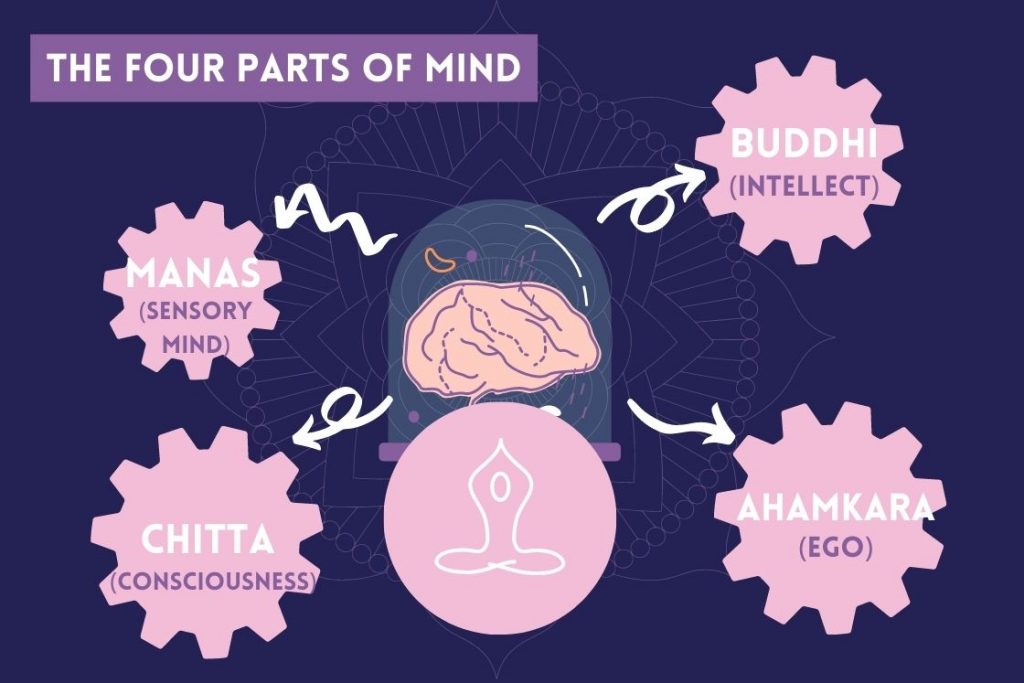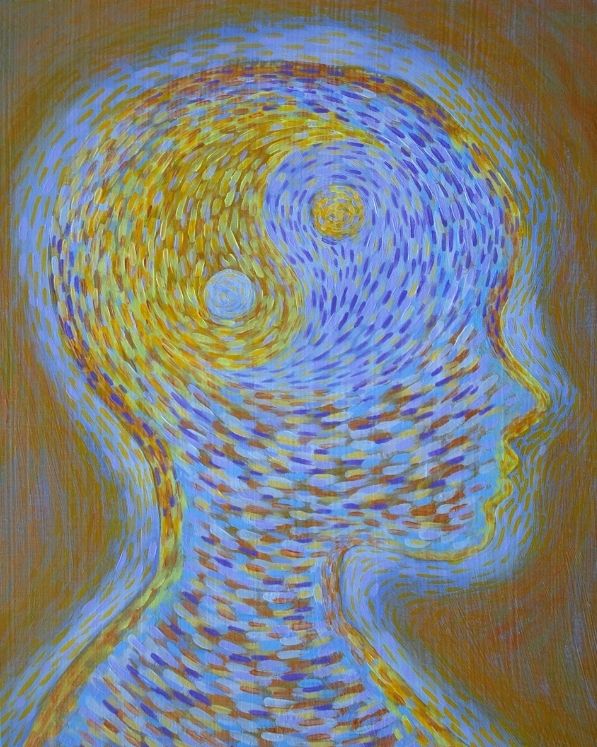
From perceiving the profession alternatives to feeling happy with attaining them and from making a call between proper and straightforward to not having the ability to neglect a painful reminiscence, is all an impression of our thoughts. The thoughts makes up the experiences and provides that means to our life.
However on account of uncountable psychological impressions, we’re stressed. It’s the thoughts’s tendency to fall for each incidence and in the end make us reside in keeping with its guidelines. Nonetheless, the aim of yoga is to reverse this conditioning and regulate the monkey thoughts to allow us to relieve the ache & miseries of the world to steer a peaceable life.
As superbly mentioned in yoga sutras itself,
“Yoga means stillness of thoughts and freedom from oscillations of assorted psychological processes.”
~ Sage Patanjali, Father of Yoga
What’s Thoughts In keeping with Yoga?
The very definition of yoga talks about silencing the thoughts. Sage Patanjali defines yoga as a follow to quieten the thoughts and the fluctuations generated by it. Which means yoga can’t be achieved with out understanding, discriminating, and coordinating the thoughts.
In yoga, the thoughts shouldn’t be seen as synonymous with the mind which has a sure area within the bodily physique and controls logical operations. The yogic idea of thoughts combines all of the aware and unconscious exercise of an individual. It consists of our ideas, emotions, reminiscences, beliefs and even the ego that makes us understand our existence.
When the thoughts is conditioned, it helps the physique by means of each expertise and situation. The thoughts is the supply of enjoyment and ache. It’s the thoughts, which might additionally lead us to the upper phases of Samadhi. Sage Patanjali emphasised the paramount significance of the thoughts. That’s why he has mentioned the methods to self-discipline the thoughts (Yamas and Niyamas) even earlier than he defined the bodily postures, meditation and respiratory workouts.
What makes the thoughts “MIND”?

Most western theories take a look at the thoughts as one single unit. However in yogic understanding, there are 16 dimensions of a human thoughts, categorized into 4 components. These classes are Manas, Chitta, Ahamkara, and Buddhi – the 4 components of the thoughts to harness by means of yogic follow.
These 4 components of the thoughts work in coordination with one another to allow us to expertise the world. Think about them spokes on a wheel. The wheel rotates to present us perceptions of actuality, whereas the core (thoughts) stays nonetheless. That is the best situation of yoga, an undistracted, nonetheless core!
1. Manas – Which retains the reminiscence
Manas, in keeping with yoga, is the fundamental a part of the thoughts, related to getting the exterior info within the system. Its perform is to grasp and determine the vital and essential sensory info to cross to the interior system. Manas has the power to query and doubt, which typically can result in psychological difficulties.
Typically thought-about much like the mind in its perform, Manas is a controller of the 5 sensory organs and 5 organs of motion. It guides the thoughts to numerous instructions which can be vital.
Nonetheless, Manas doesn’t have the authority to take the ultimate resolution, it depends largely on the mechanisms of Buddhi. Since it’s accountable for the sensory organs, Manas is straightforward prey for our wishes, needs, sights, and aversions.
2. Chitta – Which makes us conscious
It’s essential to have heard phrases reminiscent of ‘Supreme consciousness’ or ‘Pure consciousness’.
Chitta is crucial a part of our thoughts which is expounded to consciousness. Consider the thoughts as a magnetic plate. Now, no matter comes and goes off this plate, which makes us conscious of these objects (ideas, reminiscences, emotions, sensations, and environments) is Chitta truly.
Chitta in yoga is that property of the thoughts which makes us conscious of the objects, whether or not we’re in a waking or sleeping state (consciously or unconsciously).
It’s mentioned, all of us are a part of ‘Common’ or ‘Supreme consciousness’ initially after we take delivery on this earth, however as ego (Ahamkara) begins evolving in our thoughts, ‘Particular person consciousness’ slowly begin going down of that ‘Common consciousness’. Yoga, by numerous technique of follow, symbolizes the union of ‘Particular person consciousness’ with ‘Common consciousness’. The consciousness of a person being is ‘soul’ (Atma) and its union with the common one makes it ‘supreme soul’ (Paramatma).
3. Ahamkara – Which gives sense of Identification
Ahamkara could be outlined because the particular person’s ego or the sense of ‘I-ness’. Nonetheless, it’s way more than ego. Ahamkara offers identification to the person and makes her or him distinctive. Though it’s a separate and particular attribute to the person, Ahamkara typically results in emotions of alienation, ache, or loneliness.
If Ahankara dominates, your thoughts can solely perceive and make selections solely in its contexts. It additionally impacts Manas and compels it to behave in reference to 1’s personal individuality. Ahamkara takes in Chitta as a companion to deliver the saved reminiscences related to the particular person’s ego. It doesn’t let the mind see the irrationality of these reminiscences, thereby clouding Buddhi.
Nonetheless, it’s essential to grasp that Ahamkara shouldn’t be all the time unfavourable. When an individual goals to reach yoga, she or he is in want of the dedication of “I can do it”. It’s largely provided by the particular person’s Ahamkara. A specific amount of Ahamkara is sweet for upliftment. It’s the job of Buddhi to not let it go uncontrolled and result in separation and ego.
4. Buddhi – Which work intellectually
The phrase Buddhi is derived from ‘Budh’, which suggests awakening or woke up. It’s a greater state of the thoughts, nearer to knowledge. Buddhi is the discriminating perform that judges, decides, and makes cognitive differentiation.
Within the supreme situation, Buddhi is the choice maker school of the thoughts. However it may possibly solely take smart and fruitful selections if it operates to its full capability with out being clouded by Manas, Chitta, and Ahamkara. If Buddhi capabilities correctly, the Manas takes its instructions and acts accordingly.
Buddhi is a layer of the thoughts, closest to knowledge. When it’s unclouded utterly, it encourages all the opposite layers to behave in rhythm. Buddhi is the determinant of discovering the upper reality. If we take a look at it intently, we may even see that even when it acts as a software to deepen one’s meditation to grasp the universe, it’s Buddhi that created the universe within the first place.
Interplay Amongst Manas, Chitta, Ahamkara, and Buddhi

Imbalance within the 4 components of the thoughts is the most important purpose for our disturbed and stressed minds. Manas is the controller of the sense and motion organs. However whether it is misguided by Chitta’s impressions, it tends to give up to wishes. Manas can solely management wishes if Chitta, Ahamkara, and Buddhi are behaving correctly.
Chitta’s perform is guided by egoistic ideas produced by Ahamkara. It’s unable to carry out if the reminiscence storage is barely citing the unhappy and painful ideas which should have heard the particular person’s identification prior to now.
The affiliation between Ahamkara and the reminiscences of Chitta are the most important reason for psychological issues. The reminiscences saved in Chitta get coloured by the ‘I-ness’ of Ahamkara and battle for consideration from Buddhi. If Buddhi shouldn’t be working logically, these coloured impressions drive Manas to take actions which can be neither wholesome nor good for the thoughts.
Solely Buddhi can discriminate between proper and unsuitable and command all others to make their selections proper. It could possibly perceive the false identification Ahamkara is holding on to and persuade Ahamkara of dropping it.
When Ahamkara surrenders the ego, Chitta rights itself by exhibiting the optimistic latent impressions of the thoughts. And when the Chitta is purified, Manas shouldn’t be anymore, a prey of wishes. For this, yoga emphasizes unclouding the Buddhi to make different elements of the thoughts to perform healthily. That is referred to as regulating or balancing the core by Patanjali.
Yoga to Regulate the Thoughts
Sage Patanjali talks in regards to the thoughts as a determinant of what sort of life we reside. The thoughts, constituting its 4 components, is chargeable for our gross to delicate elements of being and needs to be regulated to make sure our wholesome and sound existence. It’s doable with yoga and its ideas.
Listed here are some yoga practices that may assist you to stability Manas, Chitta, Ahamkara, and Buddhi and clear your solution to greater understanding.
1. Be conscious of Your Senses and Actions
The primary stage to manage the thoughts is to watch the workings of Manas. By observing the actions of Manas like your sensory inputs and actions, you may perceive the way it supervises and orders them to get what they need or behave in the way in which that’s most pleasing.
Being conscious of your senses and actions could make you perceive that Manas is enjoying with them, which might get you in psychological hassle. To deliver the fluctuations of Manas in management, you may follow the private and social disciplines (Yamas and Niyams). They might help you eliminate our free senses and regulate our actions to clear the way in which to peace.
2. Witness Your Ideas
Observing what comes and what goes is a vital train to domesticate the workings of Chitta. When you’re conscious of your feelings, ideas, what your thoughts is processing for a very long time, or which reminiscence your thoughts is getting caught at, you may higher regulate Chitta.
That is doable by means of deep respiratory and meditation. When the thoughts is concentrated on one single perform, the respiratory, there’s a much less probability it will get distracted. After all, it’s a course of which takes constant follow. However for those who inculcate the behavior of performing your respiratory and meditations mindfully, you may attenuate Chitta from unfavourable to optimistic.
3. Give up to the Increased Energy
Patanjali describes surrendering to the upper energy as Ishvara Pranidhana. Surrendering doesn’t imply forgetting yourselves or detaching out of your speedy surroundings. Nevertheless it means to eliminate all of the wrongful concepts about oneself.
This may be achieved by means of the follow of worship, prayers, believing, and respecting the facility of the Supreme. Yoga recommends the follow of Ishvara Pranidhana to drop off the ego from an individual so she or he can uplevel on the religious path.
Dissociating with the wrong identities and accepting there’s a reality past our personal identification is an train to coordinate Ahamkara capabilities with the system.
4. Let Go of the False Associations
Falsely figuring out ourselves with our physique, thoughts, achievements, pleasures maintain the Buddhi clouded. And till Buddhi is clouded, it can’t produce wholesome outcomes. The energy of Buddhi is its discriminatory energy, the essence of which lies in letting go of the false associations.
Apply of respiratory workouts, meditation helps perceive that there’s extra to ourselves than our pleasures, wishes, pains, and sufferings. It guides our solution to the proper identification of our true nature.
Unclouding Buddhi is crucial train as Buddhi performs a key function within the functioning of all different layers. Within the presence of clear and logical selections by Buddhi, Ahamkara drops off, Chitta will get coloured with goodness, and Manas act the way in which helpful for an individual’s peaceable life.
Going Past the Thoughts

From all of the chatter above, you will need to have understood the fundamental capabilities of the thoughts as an entire. It has direct management over breath, senses, and the physique. It influences the senses and guides them to behave. It has the power to need issues for itself which will or might not create psychological troubles. The thoughts performs these operations by means of its 4 layers.
The aim of coordinating all these layers of the thoughts is to result in peaceable and productive life away from miseries. Yoga recommends workouts like religious practices, respiratory, and disciplines to coach the thoughts and educate it to run in a means that’s much less depressing.
Nonetheless, yoga goals at a good larger objective. It’s to transcend the thoughts. It’s to assist the thoughts do not forget that the impressions attributable to it should not actual and the reality is past that.
Yogic practices assist us perceive that the Supreme Actuality is definitely the elemental side of our being and never the tales coloured by the thoughts. This decoloring of thoughts’s tales takes place when an individual performs yoga and sticks to it frequently.
Ultimate Ideas
The thoughts with its 4 elements operates on all ranges of consciousness. It’s lively after we are awake, asleep, and in a dream state. The impressions of the thoughts affect our day by day actions to an important extent. But when something goes unsuitable, we merely blame the thoughts and create extra impressions to eliminate the wrongdoing by forcing us to neglect it.
Yoga provides a more healthy solution to regulate these impressions. It recommends the practitioners to grasp and observe the 4 layers of the thoughts by means of yogic practices like disciplines, respiratory, and meditation to allow them to keep away from the wrongful impressions taking a dominant place of their minds. Yoga is a means of not forgetting the wrongdoing and shifting on however undoing the unsuitable by doing it proper at its root!
